As most people spend between a third and a half of their lives in bed, it is important to ensure that the time spent there is as comfortable as possible, and that it is easy to move around the bed and be able to get in and out of bed easily with no potential hazards.
If you are experiencing problems getting in and out of bed you may need to ask either a physiotherapist or an OT to come and assess the problem. This may be arranged through social services if you have a disability.
Sometimes there is a simple solution to the problem and the social services can provide you with some simple aids.
Each area of the country will vary what they will provide and who is responsible for providing it. This can all be discussed during the assessment.
Sometimes the equipment is regarded as home nursing equipment, i.e. that which a community nurse considers necessary to help him or her carry out nursing duties effectively e.g
- bed backrests, bed cradles, bed tables, bed rails, bed linen;
- beds such as pressure relief beds or mattresses and hospital-type nursing beds;
Many other items are considered to be daily living equipment and these will be supplied by social services.
e.g rope ladders
bed raises
lifting poles
grab handles;
hoists;
The different authorities now have a legal duty to work together to try and ensure equipment is provided as quickly as possible after an assessment of need is agreed.
Rope ladders
Rope ladders are a very cheap and effective way of helping people to sit up alone. The person needs some upper body strength in order to use this device. The person then works their hands up the ladder holding each rung to pull themselves up in to sitting. Fix the rope ladder securely to the end of their bed and make sure that the patient can reach the first set of rung handles.
There is another similar system which has straps to pull up on instead called Pull straps
Both of these systems are easily transferred to another bed if you are travelling
Grab handles
The easiest to fit and most commonly used are the rails that slide under the mattress.
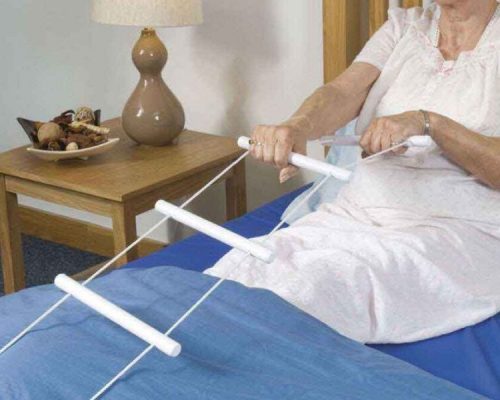
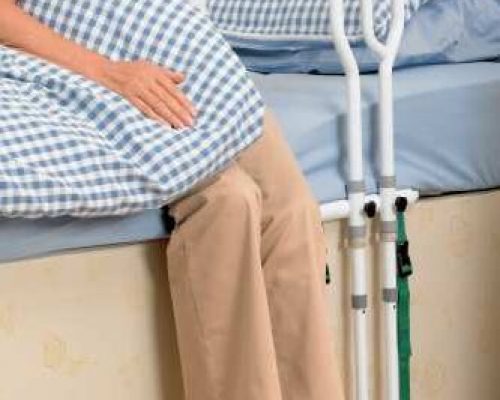
Mattress inclinators
Mattress inclinators are power operated devices that fit under the mattress and helps a person to sit up and lie down on their own. They can remain raised to form a backrest if needed to support a person in a sitting position. They are available for single or double beds.
The type of mattress you have may mean that this device is not suitable.
The other option is to get a hospital type of bed that is designed for purpose.
There are many options of hospital bed with a number of different options in the number of sections they come in. Depending on the number of sections this allows a variety of functions the bed can perform. A simple 2 section bed just allows the patient to sit up supported.
Some beds with more sections have the option to raise under the knees to stop the patient sliding down the bed. The five section bed has the best number of options. All of these can be electric or manually operated although most these days are electric..
The mattresses for these beds are either foam, latex or Both domestic and hospital versions of variable posture beds are available.
It is important to check that a hospital bed provides the functions needed. Many have a tilting mechanism and most have the option of safety sides. It is important to check that the bed is long enough for the patient and take in to account slipping down the bed as well so allow as much space as possible.
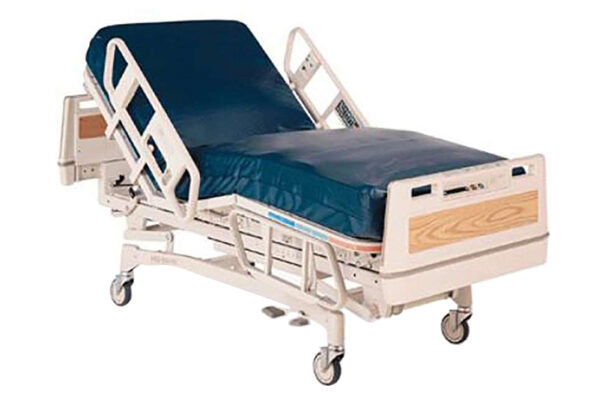
V-shaped pillows
These may be useful to keep the patient supported in half sitting.
For people who have difficulty getting their legs into bed
Manual leg lifters
These consist of a strap with a loop on the end which hooks over the affected foot/leg and the person pulls up using their arms to lift the leg up on to the bed. This needs strength in the arms and trunk and sitting balance.
There are a powered variety of these if required
For people who have difficulty moving or turning in bed
Most people need to move or turn regularly in bed, either just for comfort or to prevent pressure ulcers from forming.
Some people may find that the use of slippery nightwear or bedding such as satin pyjamas or sheets, combined with pulling on strategically placed grab rails or handles, may help them turn over or be assisted to turn over more easily.
The best way to turn over is to lift your bottom and take it as far as possible to one side of the bed. Then with the knees bent and feet resting on the bed roll both knees over to one side .The trunk will then follow and the patient can then grab the side of the bed or safety bar to pull themselves further over.
Flat sliding sheets
Carers can use the sheets not only to assist turning but also to move the person up the bed and across it. Sometimes the flat sliding sheets are used in conjunction with a flat board, which bridges any gap to help transfer the person from one lying surface to another.
How to get out of bed
Bend both knees then roll them over towards the side you are getting out
Let the lower legs drop over the side of the bed and with the hand on the mattress and the opposite elbow push up on the mattress.
For example Getting out the Right side of the bed, Roll to the Right, Bring the left hand over towards your Rt shoulder and place flat on the bed.
Press up on this hand at the same time as pushing up with the Rt Elbow.
Some people like to have a grab rail positioned under the mattress that can help them up and to make them feel more secure.
Getting in to bed is the same procedure reversed
Standing up from the bed
If you raise the height of the bed it will be much easier to stand up
The patient may also be scared of falling so place a frame in front of them if required.
They should always push up from the bed and only grab the frame when they are nearly upright. The frame is not secure until it has weight going through the arms and hands.
If a person is unable to take any of their weight through their legs, advice should ALWAYS be sought from a therapist as to the safest method of assisting or moving them out of bed.
Most probably a hoist will be needed or a slide board
The slide board can be placed between the bed and the wheelchair and works well if the patient has sufficient arm strength and balance to pull themselves across the board.
It is best to position the bed at the same or similar height to the chair they are moving to.
There are curved boards that are suitable if the chair they want to use has fixed armrests
There is also a great device called a standaid which is like a luggage trolley.
You place the patients feet on the platform at the bottom and then holding the metal frame they pull up. You are then able to wheel the patient to their chair.
Check that the Stand aid fits under the chair far enough so that when they sit down they are positioned well back in the chair. You may need a chair height adjuster to be able to fit the stand aid under the chair and also to enable the person to get back out of the chair after sitting for some time.
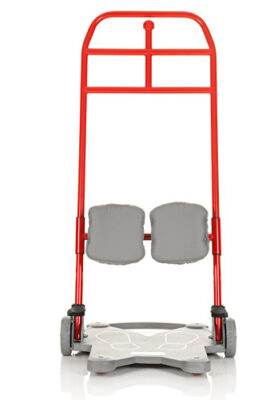
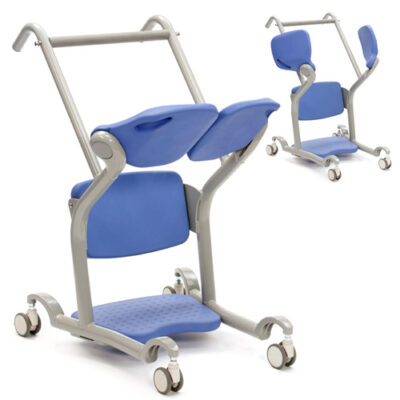
With severe disabilities an Overhead track hoist may be the best solution.
This allows the patient to transfer from bed to a chair in another room easily.
Mobile hoists
A small mobile hoist can be very useful and there are a variety of designs available.
The type of sling depends on the needs of the patient.
Things to take in to account when using a hoist
- make sure there is sufficient space under the bed for the chassis and wheels of the hoist;
- if raisers are recommended to raise the bed for hoist access, ensure (if the increased height would make existing transfers more difficult) that they are only fitted when the hoist is available for use;
- is there room to move the hoist away from the bed with the person sitting in the sling? It is preferable to leave enough space to pull the hoist straight back and wheel a wheelchair or commode in under the person to avoid the carers having to turn the hoist and risk twisting their backs;
- will the furniture need rearranging to make sufficient space to manoeuvre the hoist?
- can the hoist be pushed easily over the floor covering? Thick pile carpet and thresholds can be difficult;
- if the height of the bed has been raised (e.g. by adding an extra mattress for pressure relief) can the hoist still lift the person so that his/her bottom clears the mattress surface?
- if the person falls, will the hoist reach down far enough to lift him/her from the floor?
- where will the hoist be stored when not in use?
Turning discs
These are made up of two circular discs that rotate against one another. They are useful for someone who can semi-stand or who can use a board as a bridge (but finds it difficult to turn, step or adjust his/her feet) to transfer directly from bed to chair. Users place their feet on the disc and, as the transfer is made, the disc swivels.
A handling belt worn by the person can make it easier for a carer to help guide him/her around in a semi-standing position or across the board.
It is difficult to support someone on a turning disc. If support is needed ask for an occupational therapist or physiotherapist to assess the situation. One possible solution is a turning disc with a frame which the person can hold onto.
Handling belts
These are strong belts that you put on the patient which have handholds that the carers can grasp to guide the patient the right direction and give the patient an added feeling of security.
For people with incontinence issues
It is important to use Waterproof bedding for mattress, Duvet and pillows
This may be noisy and increase sweating
A drawsheet can be laid across the middle of the bed to cover the area under the pelvis.
These will be combined with other incontinence pads
See Incontinence article
If you have Back pain- PHYSIO TIPS
Be sure to choose the right bed for your condition. A very temporary solution can be to put a board under the mattress.
However if you can afford it and your mattress is old the best solution is to buy a new mattress.
There was a marketing ploy a few years ago to market all good mattresses as orthopaedic mattresses.
These may not necessarily be the best option for you.
Highly recommended are Vi Spring beds. There are a variety of types either bought directly from the company or via John Lewis.
Remember we spend at least one third of our lives in bed – this is a lot of time to suffer an uncomfortable bed.
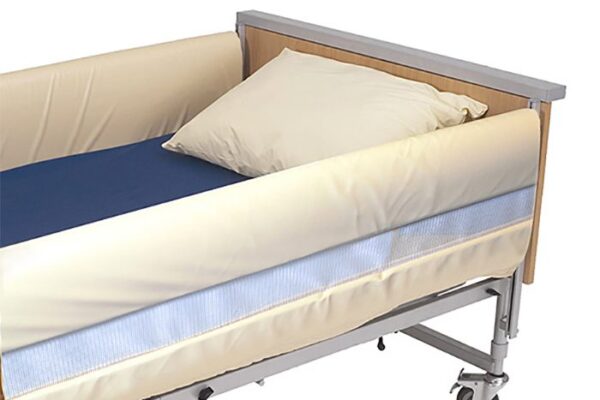
For people who may fall or try to get out of bed unaided
The best option is to get cot sides
These help prevent a person from rolling out of bed accidentally. The full cot sides are for use only when there is a carer to let down the sides as these can only be lowered with the safety catch buttons on the outside
If the patient lives alone and has issues with falling then it is best to try simpler methods first like tucking in the sheets well, putting things down on the floor to break the fall and to make sure the patient has an alarm button round their neck to call for help if they do fall.
If there is any issue with pressure sores
The patient might need some form of airflow mattress combined with possibly other things such as heel pads or sheepskin.
For eating in Bed
Beanbag Trays
The beanbag on the underside of the tray moulds to the shape of the lap to provide a more stable surface than a traditional tray. The trays are available with raised edges, recesses for plates and cups and slip-resistant tray mats. They come in a choice of designs and some have detachable beanbag bases for washing.
Bed tables
You can get a variety of hospital style tables that go over the bed.
Extracts from DLF

